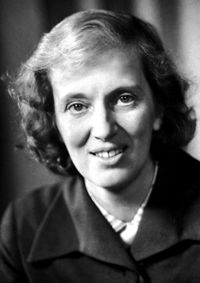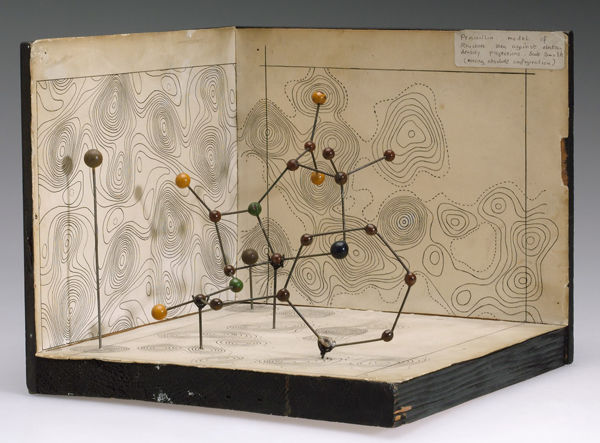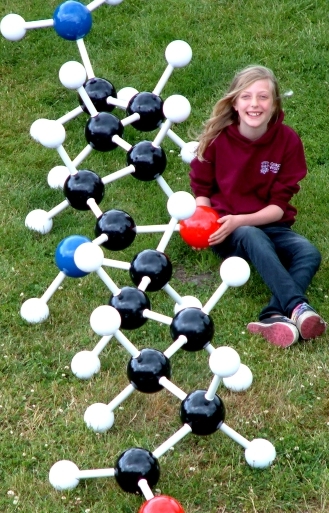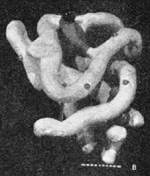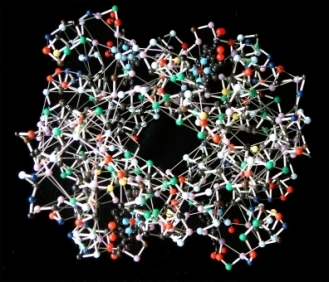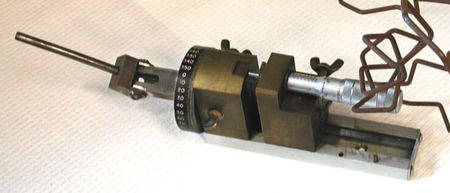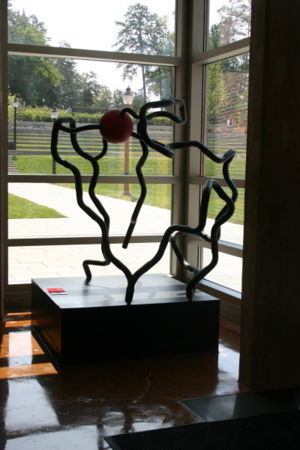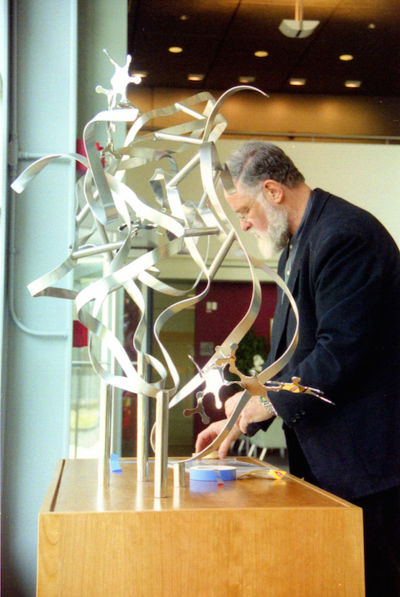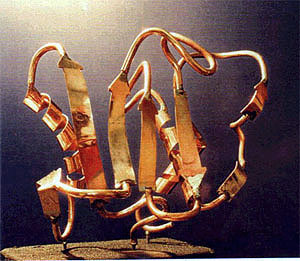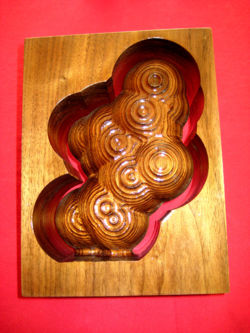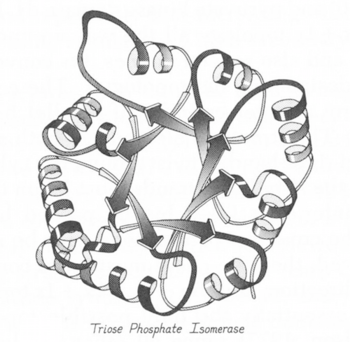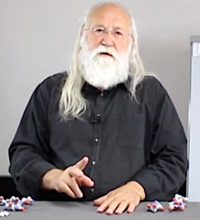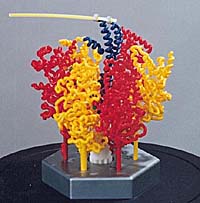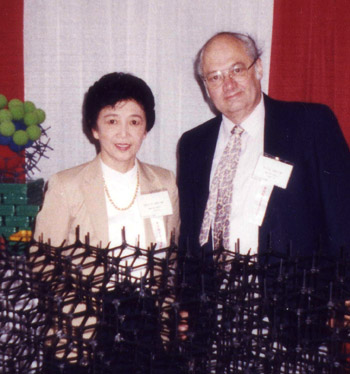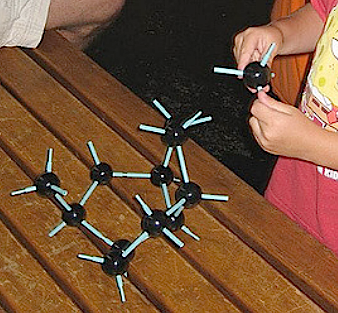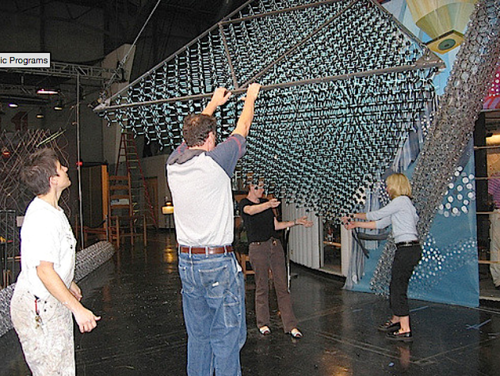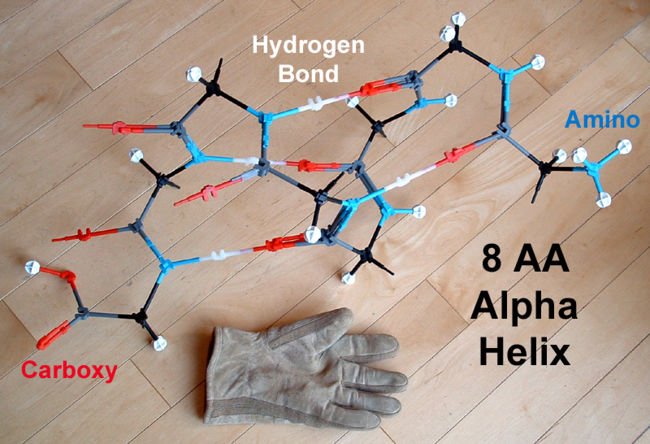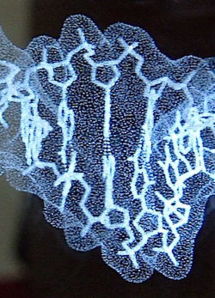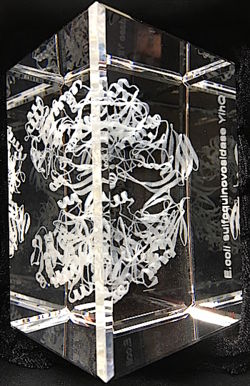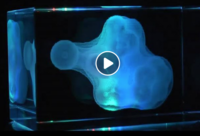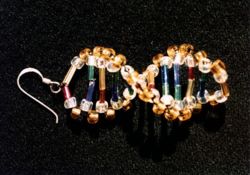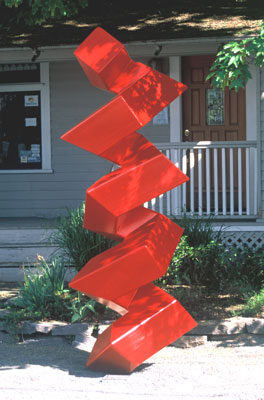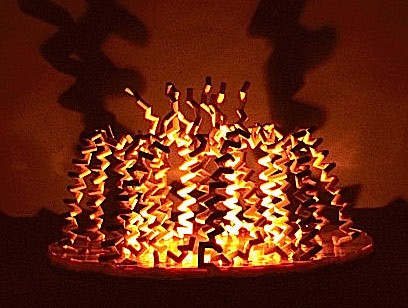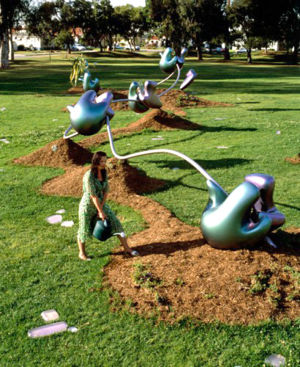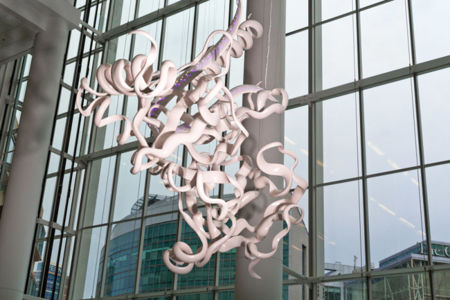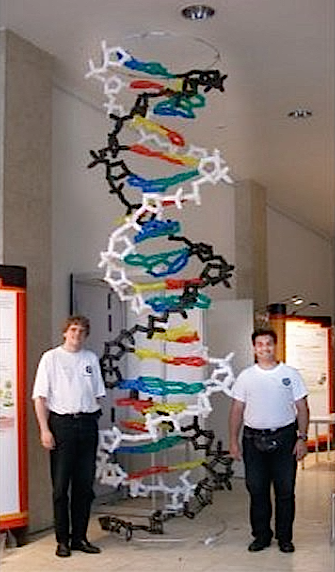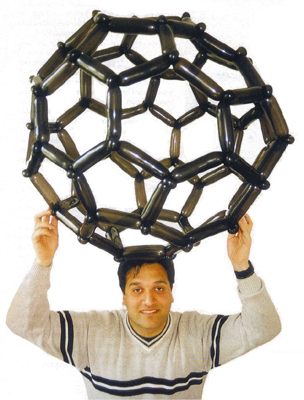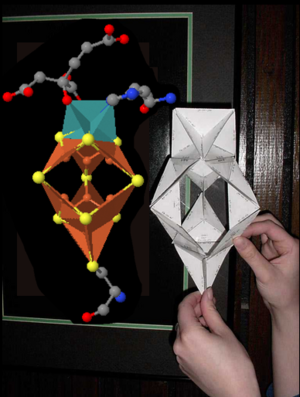Art:Molecular Sculpture
From Proteopedia
Physical models of macromolecules were important for scientists to understand protein structures when the first protein crystal structures were determined. From 1958 into the 1960's, these included brass wireframe models[1], facilitated by the Richards optical comparator, and smaller ball and spoke models[2]. By the early 1970's, computers were still not yet commonly capable of rendering macromolecular models (see History of Macromolecular Visualization). At that time, Byron's Bender was a popular way of making scientifically accurate protein backbone models. As computers took over scientific visualization in the 1980's and beyond, physical models became works of art as well as science. However, physical models remain very important in education[3][4], because some students learn by tactile exploration better than from a computer screen, and most students learn better when tactile exploration of physical models is available[5][6][7][8].
The scope of this article is primarily limited to sculptures and physical models of macromolecules. Some of this article was adapted from an earlier website[9].
Dorothy Crowfoot Hodgkin
|
Dorothy Crowfoot Hodgkin (source). |
|
Molecular model of penicillin by Dorothy Crowfoot Hodgkin, ca. 1945. Behind the model are projections of the electron density map. By Science Museum London / Science and Society Picture Library. Creative Commons Attribution-Share Alike 2.0 License. Source: Wikimedia Commons. |
Dorothy Crowfoot Hodgkin[10] (1910-1994) was an eminent and ground-breaking crystallographer, who won the 1964 Nobel Prize in Chemistry for pioneering X-ray diffraction work that included solving the structures of penicillin (1949[11]) and vitamin B12 (mid-1950's[12]). She was 69th to win the Nobel in Chemistry, but only the third woman to win it, after Marie Curie and her daughter Irène Joliot-Curie[13]. In 1945, she solved the structure of penicillin. The structure had been controversial prior to her work, published in 1949[11]. In 1971, she was a member of the team solving the structure of insulin[14]. The insulin structure was solved at the time the Protein Data Bank was being founded, and was not deposited until 1980 as 1ins, superceded by 4ins in 1989[15].
An excellent 4.5 minute video by Huy Do Duc (Hochschule für Technik und Wirtschaft, Dresden) explains the science behind this model. The video is available at the Museum of the History of Science (Oxford, UK).
Beevers -> Miramodus
|
Giant model of the monomer of nylon from Miramodus.Com. Photo used with permission[16]. C H N O |
There is a strong tradition of model making in the Chemistry Department of Edinburgh University. Alexander Crum Brown, Professor of Chemistry from 1869-1908, was a pioneer in this field. In the Year the Crum Brown retired, Cecil Arnold Beevers was born in Manchester. In 1929, he became involved, under the influence of Lawrence Bragg in Manchester, in research in crystallography. With Henry Lipson, he made a major contribution in the Beevers-Lipson Strips, a computational aid in calculating Fourier transforms to solve structures crystallographically.
|
The first 3D protein structure: myoglobin at ~6 Å by Kendrew et al..
|
In 1958, John Kendrew (Nobel Prize 1962 with Max Perutz) and coworkers published the first structure of a protein, myoglobin[17]. It was a low resolution (6 Å) structure that looked unsatisfyingly asymmetrical. By 1961[18][19], the Kendrew group had achieved atomic resolution for myoglobin. Initially, they built brass models at a scale of 5 cm/Ångstrom. The models were built and supported within a forest of 2,500 vertical rods arranged to fill a cube six feet (2 meters) on a side. Colored clips were attached to the rods to signify electron density, and guide the building of the model. The forest of rods obscured the view of the model and made it hard to adjust. Its size made it cumbersome and problematic to move. See photo 1 and photo 2.
|
Beevers type ball and spoke model of hemoglobin at 1 cm/2 Å, available from Miramodus.Com. Hemoglobin is about 60 Å across, so the model is about 30 cm (1 ft) across. This model has one ball per residue (574 balls). It is not an all-atom model, which, if hydrogen is included, would have 8,800 atoms. Photo used with permission[16]. |
In 1965, seeking smaller and more portable models, Kendrew collaborated with Alexander A. Barker, who constructed ball and spoke models using parts provided by Beevers. These were 1 cm/Å, one fifth the scale of Kendrew's original myoglobin model, later called Beever's Miniature Models. Kendrew started to take orders for these models of myoglobin in May 1966. The price was set at £210 (roughly $600 US), a considerable sum at the time, equivalent to about $4,600 US in 2018. In all, 29 orders were received between May 1966 and March 1968 for models which were produced at the rate of one per month. SEE PHOTOS.
Beevers style ball and spoke models of proteins remain available in 2018 from Miramodus.Com. The scale for proteins is 1 cm/2 Å.
When it comes to larger sculptures, Miramodus "Giant Models" make a striking impression: see the photo of the nylon monomer, above left.
Streaming video is available for Eric Francoeur's 40 min talk in 2011 Handling Macromolecular Structures, an illustrated review of the history of physical macromolecular models and computer representations, and the interplay of science and art.
Byron Rubin
Byron's Bender
|
Byron's Bender, alongside wire model created with it. Photo provided by Leonard Banaszak (Univ. Minnesota) to Bernhard Rupp for use in his 2009 book Biomolecular Crystallography: Principles, Practice, and Application to Structural Biology. Used with permission[20]. |
|
Byron's Bender wire model of the backbone trace of the I domain of CD11a (from 1lfa), an alpha/beta domain of a leukocyte integrin adhesion molecule. Alpha helices are decorated with red pipe cleaners, while beta strands are decorated yellow. Model generously constructed by Tim Herman in 1997. Photo by Eric Martz. |
Byron Rubin, while working as a crystallographer with Jane Richardson in the early 1970's, invented a machine for bending wire to follow the backbone trace of a protein[21][22]. Kendrew-style brass wireframe models, then popular, were large and cumbersome. The small backbone wire models from Byron's Bender were the most manipulable and portable models available at the time.
An example illustrating the importance of models from Byron's Bender occurred at a scientific meeting in the mid 1970's. At this time, less than two dozen protein structures had been solved. David Davies brought a Bender model of an immunoglobulin Fab fragment, and Jane and David Richardson brought a Bender model of superoxide dismutase. While comparing these physical models at the meeting, they realized that both proteins use a similar fold, despite having only about 9% sequence identity. This incident[23] was the first recognition of the occurrence of what is now recognized as the immunoglobulin superfamily domain in proteins that are apparently unrelated by sequence.
Byron's Bender remained available through the 1990's. Tim Herman, then of the Medical College of Wisconsin (later he founded[3][4]) was one of its last avid users. Tim brought the Bender into local high schools and taught teachers and groups of students how to construct models.
Aside from the importance of the tactile as well as visual input these models provide, another of their great strengths is that they jiggle and vibrate when handled, thereby simulating thermal motion. Too often users of computer models lose sight of the fact that protein molecules in living systems are constantly flexing due to thermal motion.
(Text in this section was adapted by Eric Martz from his earlier version at History.MolviZ.Org.)
Muffler Pipe
|
Muffler pipe sculpture of rubredoxin, 1973, by Byron Rubin. Seven feet tall (2 m). Shown in the French Family Science Center at Duke University, Durham NC USA. Photo used with permission[24]. |
Shortly after conceiving the idea for his Bender, crystallographer Byron Rubin realized that the machine used in Midas Muffler shops to customize automobile tailpipes operated on a similar principle, but at larger scale. He collaborated with the local shop to construct a backbone sculpture of rubredoxin about 5 feet high from stainless steel tailpipe. Rubin's rubredoxin sculpture won the Chandler competetion at the University of North Carolina in 1973. It stood in the lobby of the Paul M. Gross Chemistry Building at Duke University, Durham NC USA from 1973-2008. Since 2008 it has been in the atrium of the French Family Science Center at Duke.
MolecularSculpture.Com
|
Byron Rubin completing the installation of his sculpture of follicle stimulating hormone in 2002 at EMD-Serono, Rockland MA. Photo used with permission[24]. Photo by Eric Martz. |
| Sculpture of human neutrophil collagenase by Byron Rubin on permanent exhibition at the Smithsonian Institution, Washington DC USA. Image copyright © 2001, Byron H. Rubin, used with permission[24]. Height: 11 inches. |
In the mid-1990's, Byron Rubin resumed the creation of molecular sculptures such as the collagenase ribbon model shown at right. In his workshop near Rochester, NY, he has constructed many beautiful protein molecular sculptures of all sizes, often for pharmaceutical companies. These can be seen at his website, MolecularSculpture.Com.
Edgar Meyer
The following text and image were submitted[9] in 2004 by Edgar Meyer (1935-2015). Citations have been added.
|
Sculpted walnut model of D-tartaric acid, the cornerstone of stereochemistry and chirality. By Edgar Meyer. |
- Early in his scientific career, Edgar Meyer made three seminal contributions to the structural sciences: the first use of color graphics for molecular modeling (1968), the initiation of the Protein Data Bank (1969-1971)[25], and the first use of networking in the life sciences (1971). These three tools[26] are the very basis of web-based structural studies so essential to the life sciences and are a source of inspiration for his artistic efforts.
- At the end of 40 years as a productive crystallographer, he spent the last 10 years [1994-2004] developing the software and hardware tools necessary to create precisely scaled models of molecules in the form of molecular sculptures. Program SCULPT reads atomic coordinates and, together with orientation and control parameters, generates “G” code for a cnc milling machine.
- Some of the sculptures are derived directly from his crystallographic studies of proteolytic and hydrolytic enzymes. The trinitatis series of sculptures comes directly from his initial observation of amazing repeats of single amino acids in proteins[27].
- These sculptures merge art and science; they invite the viewer to touch the contoured surfaces depicting atom-atom juxtapositions. The warmth and texture of noble hardwoods is the medium most frequently used for these sculptures. Commissions by the Boston Museum of Science and the Smithsonian are depicted in his web site molecular-sculpture.com.
- In addition to a variety of molecular sculptures shown there, abstractions based on atomic surface representations and juxtapositions are also illustrated. These abstractions are inspired by the wood itself.
Photographs of larger sculptures and macromolecular subjects are available[28][29][30].
Jane S. Richardson
|
Jane S. Richardson's hand drawn ribbon representation of triose phosphate isomerase, published in 1980[31]. Image from Wikimedia Commons, under the Creative Commons Attribution 4.0 International license.
|
Crystallographer Jane Richardson is not known for protein molecular sculpture, aside from her involvement with wire models made with Byron's Bender[21][23]. However, she made an indelible impact on protein sculptors by introducing and popularizing simplified and beautiful drawings of protein backbones starting in 1980, notably schematic ribbon diagrams[31][32][33][34][35][36].
By simplifying protein models from imponderable masses of atoms to elegant ribbon diagrams, she facilitated scientists' understanding of protein folds and their families and superfamilies. Her influence can be seen some sculptures by Mara G. Haseltine, glass blocks by Patrick Goldsmith, and in the later sculptures of Byron Rubin.
Tim Herman
|
Tim Herman in 2015 explaining secondary structure on YouTube. The Center for Biomolecular Modeling has posted many videos on YouTube. |
|
An educational, interactive model of ATPase, a molecular motor, built at the MSOE Center for BioMolecular Modeling and painted by hand. Courtesy 3D Molecular Designs. |
Tim Herman joined the faculty of the Medical College of Wisconsin in 1980. In 1998 he moved to the Milwaukee School of Engineering to establish the Center for Biomolecular Modeling, and in 1999 3DMolecularDesigns.Com. They use diverse rapid prototyping and other methods to create 3-D physical models of proteins and other molecular structures for biomedical researchers, and innovative educational models for educators. Their educational products are developed in collaboration with experienced teachers and field-tested in classrooms.
|
Antibody bound to lysozyme antigen. Large (16 x 6 in/40 x 15 cm) backbone model of the Fab fragment of a mouse IgG1k antibody bound to hen egg white lysozyme 1dkl. The epitope (on lysozyme) and paratope (on the Fab) have spacefilled atoms, enabling one to feel the shape complementarity of the binding. The catalytic cleft of the lysozyme is not occluded by Fab binding, and a tetrasaccharide substrate model is available. Some hydrogen bonds, and all disulfide bonds, are shown. Glu35 and Asp52, the key catalytic residues of lysozyme[37], are spacefilled. Nylon model courtesy Tim Herman and 3D Molecular Designs. Photo by Eric Martz. |
Arthur Olson
Arthur Olson founded the Molecular Graphics Laboratory in 1981 at The Scripps Research Institute. Jon Huntoon joined around 2005 to set up a 3D printing service, the Scripps Physical Model Service, which ran until 2017. The Olson group pioneered Augmented Reality, where a hand-held physical model is rendered via camera on a computer, with additional structures or properties represented, responding to manual manipulation in real time[38][39]. Olson participated in David Goodsell's Molecular Graphics Art Shows in 1994 and 1998.
(Awaiting permission to reproduce an image here.)
Stephen Darling
|
Above: Giant model of a field-effect transistor made with Darling model parts encased in transparent plastic spheres. Vertical cylinders are carbon nanotubes. Horizontal layers are gold or platinum. Part of the Nanoscape project at the Exploratorium in San Francisco, 2006. Copyright 2006 by The Exploratorium. Used with permission[40]. |
Stephen D. Darling[41] founded DarlingModels.Com in 1986. These inexpensive models are quite useful for amino acids, polypeptides, alpha helices and beta sheets as well as a wide range of organic and inorganic structures. In 2006, the San Francisco Exploratorium obtained >60,000 parts and had visitors assemble a large diamond model, carbon nanotubes, and a walk-through field effect transistor with gold and platinum layers in their Nanoscape project. See giant model photos.
|
Above: Stephen and Ofelia Almazar Darling in 1989. Foreground is a model of diamond. Photo provided by Stephen Darling, used with permission. |
|
Detail of diamond model components at the Exploratorium (see legend at right). |
|
Scientist Jill Johnson (right), Project Manager Karen Cook (left), and other staff (unidentified) installing the giant Darling model of a diamond in the Nanoscape project at the Exploratorium in San Francisco, 2006. Detail shows Darling model components used in this model of diamond. Copyright 2006 by The Exploratorium. Used with permission[40]. |
|
Alpha helix main chain (8 amino acids, sidechains absent) constructed from Darling models. Alpha Carbon, Carboxy Carbon, Oxygen, Nitrogen, Hydrogen. Assembled and photographed by Eric Martz. |
Bathsheba Grossman
|
Short segment of DNA double helix (B form; based on the crystallographic result in 1au7) etched by LASER in a block of optical-quality glass by CrystalProtein.Com. Photos by Eric Martz. | |
Sculptor Bathsheba Grossman (Bathsheba.Com) makes geometric sculptures of mathematically inspired objects from originally designed computer datasets, using rapid prototyping technologies or laser cutting of sheet metal. She also makes glass blocks containing laser-etched models of macromolecules, which she calls "Crystal Proteins" (CrystalProtein.Com). These can be designed to customer specifications. Here is a description of her methods.
See a 3D (rotatable) rendering of the DNA model at right, and click 3D Preview in her Gallery for protein and other models.
Patrick Goldsmith
|
E. coli sulfoquinovosidase, asymmetric unit of 5aee, etched in a glass block by Luminorum.Com. Photo used with permission[42]. |
Luminorum.Com, founded in 2005 by father and son Patrick and Alex Goldsmith, sculpts laser-etched protein molecules and other objects into optical-quality glass blocks.
| Penicillin molecular model in glass, rendered by Luminorum. Click to play video. |
Luminorum has rendered in glass Dorothy Crowfoot Hodgkin's 1945 structure of penicillin. A video is available through Luminorum's Facebook page.
Atkins, Roderick & Flammer
|
A DNA earring -- genetic jewels. Constructing these is an educational activity which provides step by step instructions. |
In 1992, as participants in Evolution and the Nature of Science Institutes (ENSI) at Indiana University, Thomas Atkins and Joyce Roderick developed an educational activity for making DNA earrings. In 2004, the project was adapted to the website by Larry Flammer. A detailed lesson plan is provided along with step by step instructions for constructing DNA earrings.
In Amherst MA USA, junior high school students have made these to sell for fundraising.
Julian Voss-Andreae
|
Voss-Andreae's "Alpha Helix for Linus Pauling" (used with permission). The 10-foot (3 m) sculpture was created to honor the memory of Linus Pauling, who discovered the alpha helix in 1951. In order to emphasize the tension between the natural environment and man's image of nature's building block, the piece was powder coated in primary red, complementary in color to the green foliage embracing it. The sculpture is located in front of Linus Pauling's boyhood home 3945 SE Hawthorne Boulevard in Portland, Oregon, now home of the Linus Pauling Center for Science, Peace, and Health, which commissioned the piece. Photo used with permission[43]. |
Julian Voss-Andreae (JulianVossAndreae.Com) trained as a physicist in Europe and then as an artist in Portland, Oregon USA. His works include human forms, mathematical forms, and some inspired by protein and nucleic acid molecular structures. His construction of Angel of the West, inspired by the structures of antibody molecules, is featured in this video, along with others of his works. Voss-Andreae submitted[9] the following description in 2004:
- Voss-Andreae's current body of work plays on the sensuality and beauty which underlies sense and being itself. His work takes a literal look at the foundation of our physical existence. Voss-Andreae creates sculptures of proteins, the universal building blocks of life. More important for him than accurately copying a molecule in all its details is finding a guiding principle and following it to see whether it yields artistically interesting results. The main idea underlying all his protein sculptures is the analogy between the technique of mitered cuts and protein folding. His work resembles nature in its algorithmic quality. The former physicist calculates the cutting angles from scientific protein data using computer software he developed for that purpose. Beside the deterministic side of his work, there is an equally strong intuitive and irrational side, where his pieces stop working as scientific models and become pure art objects. Voss-Andreae's sculptures offer an emotional experience of a world that is usually accessible only through our intellect.
|
Julian Voss-Andreae standing in his studio with his completed sculpture "Angel of the West", 2008. The core of this sculpture is a scientifically accurate rendering of an antibody molecule. Stainless steel, 12' x 12' x 4' (3.70 x 3.70 x 1.20 m). Permanent location: The Scripps Research Institute (Jupiter, FL). Used with permission[43]. |
|
Light Harvesting Complex by Julian Voss-Andreae, 2003. 22” x 25” x 25” (56 x 64 x 64 cm). Photo used with permission[43]. |
Mara G. Haseltine
|
Waltz of the Polypeptides by Mara G. Haseltine, who is seen watering the surrounding garden. Photo used with permission[44]. |
Mara G. Haseltine (Calamara.Com) is a sculptor whose work includes stylized representations of cell structures (mitochondrion) and biologically important molecules. One large work, Waltz of the Polypeptides (2003), depicts ribosomes positioned along the messenger RNA for B-lymphocyte stimulator hormone, translating the genetic code into that protein. This sculpture stands on the grounds of Cold Spring Harbor Laboratory, Long Island New York. Haseltine says:
- The sculpture depicts the discovery of what has become cornerstone of modern molecular biology, the polyribosome in the act of creating a specific protein. The nascent polypeptide emerges from the ribosomes as they travel along the messenger RNA. The genetic code of the protein is denoted on the thin tube representing the message. [This] work of art entices the interest of scientists, visitors and students alike. Their questions illuminate the fundamental aspects of biology.
|
Homologous Hope by Mara G. Haseltine, 2014. Photo used with permission[44]. |
Another large sculpture, Homologous Hope (2014), hangs in the atrium of the Basser Center at the University of Pennsylvania Medical campus. Haseltine says:
- The Basser center is devoted to the discovery of ways to prevent and treat inherited breast cancer. Mara interviewed the scientists and the donors for inspiration. Her choice of subject, the BRCA-2 protein, reflects the interests of both. John and Mindy Gray, the donors of the Basser Center, wished the sculpture to honor the memory of Mindy’s sister who died of BRCA related breast cancer.
- Homologous Hope depicts a key activity of the BRCA-2 protein, correctly joining the broken ends of DNA. Some inherited forms cancers, breast, ovarian and prostate, arise as a consequence of defects that render the protein incapable of performing this essential function.
- Homologous Hope is a delicate work of art that floats like a cloud above the atrium. Patients and their families entering the building look up and see hope on the horizon, hope inspired by the generosity of the Grays, by the creative environment of University, and by the efforts of the dedicated doctors and scientists.
In 2016, Hasentine installed SARS Inhibited in a reflecting pool in Singapore's Biopolis. Twelve meters wide, it represents a backbone trace of an X-ray structure of the main SARS protease 1p9s.
Eckhardt, Karim & Rehbein
|
DNA double helix constructed with balloons with (left to right) Marcus Rehbein and Asif Karim. Construction time: about two days (?). |
|
Buckminster-fullerene (buckyball, C60) constructed with balloons, held by Asif Karim. All carbon atoms are sp2-hybridized. Three balloons lead away from each knot. The free orbital is symbolized through a pinch-twist. With practice, can be constructed in 80 min. |
At BalloonMolecules.Com / BallonMolekuele.de, Rolf Eckhardt, Asif Karim, and Marcus Rehbein describe their educational initiatives using balloons to construct molecular models. Instructions are given for "knotting" balloons in order to sculpt inexpensive and fun molecular models. Detailed steps for particular molecules are not given, however. Finished models are pictured for tetrahedron, octahedron, Buckminster-Fullerene, diamond, graphite, faujasite, cuban cluster, and a DNA double helix.
|
Marcus Rehbein, Rolf Eckhardt, and Asif Karim holding respectively: diamond; cubane cluster; faujasite, a silicate mineral in the zeolite family. |
Bob Hanson
|
The active site of nitrogenase, which fixes nitrogen in anaerobic bacteria. Molybdenum at the top, iron at the bottom, and six additional iron atoms. Believed to be the site where N2 complexation occurs. Left: JSmol. Right: Origami. Adapted from Hanson's Gallery of Molecular Origami. |
Bob Hanson (St. Olaf College, Northfield, MN USA) is notable for being the primary developer of JSmol, the molecular visualization engine upon which Proteopedia depends. He has also developed molecular origami to engage chemistry students, and published the book Molecular Origami: Precision Scale Models from Paper. His Molecular Origami Website describes a method for producing precision scale molecular models from paper. Models are marked with interatomic distances in picometers and bond angles in degrees. Data are from experimental measurements involving x-ray, neutron, and electron diffraction and ultraviolet, infrared, Raman, microwave, and NMR spectroscopy. Data based on calculation in the form of MOL or XYZ files may also be used as a basis for generating models. The online database includes a searchable library of nearly 1000 experimentally determined structures.
See Also
- Byron's Bender
- Category:PDB Art
- History of Macromolecular Visualization
- Molecular modeling and visualization software
- Streaming video is available for Eric Francoeur's 40 min talk in 2011 Handling Macromolecular Structures, an illustrated review of the history of physical macromolecular models and computer representations, and the interplay of science and art.
Notes & References
- ↑ KENDREW JC, BODO G, DINTZIS HM, PARRISH RG, WYCKOFF H, PHILLIPS DC. A three-dimensional model of the myoglobin molecule obtained by x-ray analysis. Nature. 1958 Mar 8;181(4610):662-6. PMID:13517261
- ↑ A. A. Barker's Models of Myoglobin at the History of Visualization of Biological Macromolecules (History.MolviZ.Org).
- ↑ 3.0 3.1 3dMolecularDesigns.Com
- ↑ 4.0 4.1 Center for Biomolecular Modeling, Milwaukee School of Engineering.
- ↑ Roberts JR, Hagedorn E, Dillenburg P, Patrick M, Herman T. Physical models enhance molecular three-dimensional literacy in an introductory biochemistry course*. Biochem Mol Biol Educ. 2005 Mar;33(2):105-10. doi: 10.1002/bmb.2005.494033022426. PMID:21638554 doi:http://dx.doi.org/10.1002/bmb.2005.494033022426
- ↑ Bain, G., Yi, J., Beikmohamadi, M., Herman, T. and Patrick, M. 2006. Using physical models to teach concepts of biochemical structure and structure depiction in the introductory chemistry laboratory. J. Chem. Educ. 83(9):1322-1324.
- ↑ Herman T, Morris J, Colton S, Batiza A, Patrick M, Franzen M, Goodsell DS. Tactile teaching: Exploring protein structure/function using physical models*. Biochem Mol Biol Educ. 2006 Jul;34(4):247-54. doi: 10.1002/bmb.2006.494034042649. PMID:21638686 doi:http://dx.doi.org/10.1002/bmb.2006.494034042649
- ↑ Harris MA, Peck RF, Colton S, Morris J, Chaibub Neto E, Kallio J. A combination of hand-held models and computer imaging programs helps students answer oral questions about molecular structure and function: a controlled investigation of student learning. CBE Life Sci Educ. 2009 Spring;8(1):29-43. doi: 10.1187/cbe.08-07-0039. PMID:19255134 doi:http://dx.doi.org/10.1187/cbe.08-07-0039
- ↑ 9.0 9.1 9.2 Much of the content of this article on Molecular Sculpture was adapted by Eric Martz from a section of the same title in his earlier project, the World Index of BioMolecular Visualization Resources. That project went off-line, inadvertantly, in 2012.
- ↑ Dorothy Hodgkin, a life by Georgina Ferry, first published 1998 by Granta Books. 2014 edition by Bloomsbury Reader. 528 pages.
- ↑ 11.0 11.1 HODGKIN DC. The X-ray analysis of the structure of penicillin. Adv Sci. 1949 Jul;6(22):85-9. PMID:18134678
- ↑ HODGKIN DC, KAMPER J, MACKAY M, PICKWORTH J, TRUEBLOOD KN, WHITE JG. Structure of vitamin B12. Nature. 1956 Jul 14;178(4524):64-6. PMID:13348621
- ↑ In 2018, only one additional woman has won the Nobel Prize in Chemistry, making four out of 177: Ada Yonath.
- ↑ Blundell TL, Cutfield JF, Cutfield SM, Dodson EJ, Dodson GG, Hodgkin DC, Mercola DA, Vijayan M. Atomic positions in rhombohedral 2-zinc insulin crystals. Nature. 1971 Jun 25;231(5304):506-11. PMID:4932997
- ↑ See Earliest Solutions for Macromolecular Crystal Structures at History.MolviZ.Org.
- ↑ 16.0 16.1 Permission obtained in April, 2018 from Gavin Whittaker at Miramodus.Com.
- ↑ KENDREW JC, BODO G, DINTZIS HM, PARRISH RG, WYCKOFF H, PHILLIPS DC. A three-dimensional model of the myoglobin molecule obtained by x-ray analysis. Nature. 1958 Mar 8;181(4610):662-6. PMID:13517261
- ↑ KENDREW JC, DICKERSON RE, STRANDBERG BE, HART RG, DAVIES DR, PHILLIPS DC, SHORE VC. Structure of myoglobin: A three-dimensional Fourier synthesis at 2 A. resolution. Nature. 1960 Feb 13;185(4711):422-7. PMID:18990802
- ↑ KENDREW JC, WATSON HC, STRANDBERG BE, DICKERSON RE, PHILLIPS DC, SHORE VC. The amino-acid sequence x-ray methods, and its correlation with chemical data. Nature. 1961 May 20;190:666-70. PMID:13752474
- ↑ Permission given in April, 2018 by Bernhard Rupp.
- ↑ 21.0 21.1 Rubin, Byron; Richardson Jane S. The simple construction of protein alpha-carbon models. Biopolymers. 1972; 11(11):2381-5. PDF
- ↑ Rubin, Byron. 1985. Macromolecule backbone models. Methods in Enzymology 115:391-7.
- ↑ 23.0 23.1 Richardson JS, Richardson DC, Thomas KA, Silverton EW, Davies DR. Similarity of three-dimensional structure between the immunoglobulin domain and the copper, zinc superoxide dismutase subunit. J Mol Biol. 1976 Apr 5;102(2):221-35. PMID:1271464 doi:http://dx.doi.org/10.1016/S0022-2836(76)80050-2
- ↑ 24.0 24.1 24.2 Permission obtained in April, 2018 from Byron Rubin
- ↑ Meyer EF. The first years of the Protein Data Bank. Protein Sci. 1997 Jul;6(7):1591-7. doi: 10.1002/pro.5560060724. PMID:9232661 doi:http://dx.doi.org/10.1002/pro.5560060724
- ↑ Memoir by Edgar F. Meyer, American Crystallographic Association History
- ↑ WWWWhy does nature stutter? A survey of strands of repeated amino acids. Edgar F. Meyer & W. John Tollett, Jr. Acta Cryst. D57, 181-186, 2004. doi.org/10.1107/S0907444900018023.
- ↑ Obituary, Edgar Meyer (1935 - 2015), American Crystallographic Association.
- ↑ Edgar Meyer's favorite structure is: co-chaperonin, Chemical & Engineering News
- ↑ Monumental Molecules by Edgar Meyer, International Union of Crystallography Newsletter 20(3), 2012.
- ↑ 31.0 31.1 Richardson JS, Tainer JA, Richardson DC. An illustrated museum of protein structures. Biophys J. 1980 Oct;32(1):211-3. doi: 10.1016/S0006-3495(80)84934-4. PMID:19431356 doi:http://dx.doi.org/10.1016/S0006-3495(80)84934-4
- ↑ Richardson JS. The anatomy and taxonomy of protein structure. Adv Protein Chem. 1981;34:167-339. PMID:7020376
- ↑ Richardson JS. Describing patterns of protein tertiary structure. Methods Enzymol. 1985;115:341-58. PMID:4079792
- ↑ Richardson JS. Schematic drawings of protein structures. Methods Enzymol. 1985;115:359-80. PMID:3853075
- ↑ Richardson JS, Richardson DC, Tweedy NB, Gernert KM, Quinn TP, Hecht MH, Erickson BW, Yan Y, McClain RD, Donlan ME, et al.. Looking at proteins: representations, folding, packing, and design. Biophysical Society National Lecture, 1992. Biophys J. 1992 Nov;63(5):1185-209. PMID:1477272
- ↑ Richardson JS. Early ribbon drawings of proteins. Nat Struct Biol. 2000 Aug;7(8):624-5. doi: 10.1038/77912. PMID:10932243 doi:http://dx.doi.org/10.1038/77912
- ↑ Vocadlo DJ, Davies GJ, Laine R, Withers SG. Catalysis by hen egg-white lysozyme proceeds via a covalent intermediate. Nature. 2001 Aug 23;412(6849):835-8. PMID:11518970 doi:10.1038/35090602
- ↑ Gillet A, Sanner M, Stoffler D, Olson A. Tangible augmented interfaces for structural molecular biology. IEEE Comput Graph Appl. 2005 Mar-Apr;25(2):13-7. PMID:15794144
- ↑ Gillet A, Sanner M, Stoffler D, Olson A. Tangible interfaces for structural molecular biology. Structure. 2005 Mar;13(3):483-91. doi: 10.1016/j.str.2005.01.009. PMID:15766549 doi:http://dx.doi.org/10.1016/j.str.2005.01.009
- ↑ 40.0 40.1 Permission granted in April, 2018 by Megan Bury, Exploratorium Permissions Staff.
- ↑ Stephen D. Darling is, in 2018, Professor Emeritus of the University of Akron (Akron, OH USA). Darling Models is headquartered in Stow, OH USA.
- ↑ Permission granted by Patrick Goldsmith of Luminorum.Com in April, 2018.
- ↑ 43.0 43.1 43.2 Permission obtained in April, 2018 from Julian Voss-Andreae.
- ↑ 44.0 44.1 Permission granted April, 2018 from Mara G. Haseltine.
